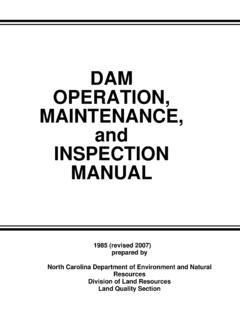Transcription of Overview of Interstate Hydrogen Pipeline Systems
1 Overview of Interstate Hydrogen Pipeline SystemsANL/EVS/TM/08-2 Environmental Science DivisionAvailability of This ReportThis report is available, at no cost, at It is also available on paper to the Department of energy and its contractors, for a processing fee, from: Department of energy Office of Scientific and Technical Information Box 62 Oak Ridge, TN 37831-0062 phone (865) 576-8401 fax (865) 576-5728 report was prepared as an account of work sponsored by an agency of the United States Government. Neither the United States Government nor any agency thereof, nor UChicago Argonne, LLC, nor any of their employees or officers, makes any warranty, express or implied, or assumes any legal liability or responsibility for the accuracy, completeness, or usefulness of any information, apparatus, product, or process disclosed, or represents that its use would not infringe privately owned rights.
2 Reference herein to any specific commercial product, process, or service by trade name, trademark, manufacturer, or otherwise, does not necessarily constitute or imply its endorsement, recommendation, or favoring by the United States Government or any agency thereof. The views and opinions of document authors expressed herein do not necessarily state or reflect those of the United States Government or any agency thereof, Argonne National Laboratory, or UChicago Argonne, LLC. About Argonne National Laboratory Argonne is a Department of energy laboratory managed by UChicago Argonne, LLC under contract DE-AC02-06CH11357. The Laboratory s main facility is outside Chicago, at 9700 South Cass Avenue, Argonne, Illinois 60439. For information about Argonne, see iii CONTENTS NOTATION .. vii 1 INTRODUCTION .. 1 2 COMMON FACILITY CHARACTERISTICS.
3 3 Transmission Pipelines .. 3 Compressor Stations .. 4 Metering Stations .. 5 City Gate Stations .. 6 Valves .. 6 Pig Launching/Receiving Facilities .. 6 SCADA 6 Telecommunications Towers .. 6 Access Roads .. 7 3 EXISTING STANDARDS AND REGULATIONS .. 9 4 CONSTRUCTION, OPERATION, AND MAINTENANCE .. 11 Hydrogen Pipeline 11 General Pipeline Construction Procedures .. 11 Permits .. 12 Survey and Staking .. 13 Clearing and Grading .. 13 Trenching .. 13 Pipe Stringing, Bending, and Welding .. 14 Lowering-in and 16 Hydrostatic Testing .. 17 Final 18 Commissioning.
4 18 Cleanup and Restoration .. 18 Special Construction Procedures .. 21 Road, Highway, and Railroad Crossings .. 21 Steep Terrain .. 22 Waterbody Crossings .. 23 Wetland Crossings .. 26 Blasting .. 30 Fences and 30 Rugged 30 Construction Immediately Adjacent to Other Pipelines .. 31 iv CONTENTS (Cont.) Aboveground Facility Construction Procedures .. 33 Compressor Stations .. 33 Meter Stations, Valves, and Pig Launcher/Receiver 34 Telecommunications Towers .. 35 Corrosion Protection and Detection Systems .. 35 Operation and Maintenance .. 36 Monitoring and Maintenance .. 36 Pipeline 37 Future Plans and Abandonment .. 37 Reliability and Congestion Issues.
5 37 Transmission Enhancement Technology .. 38 5 REFERENCES .. 39 FIGURES Bulldozer Grading Pipeline ROW .. 13 Pipeline Trenching Operations .. 14 Pipe Bending Machine .. 15 Pipeline 15 Crew Coating a Pipeline Field Joint .. 16 Crew Lowering a Pipeline into a Trench .. 17 Trench Backfilling 17 Typical Open-Cut Waterbody Crossing Method .. 24 Typical Dam-and-Pump Waterbody Crossing Method .. 25 Horizontal Directional Drilling 26 Typical HDD Waterbody Crossing Method .. 27 Typical Pipeline ROW in 28 v FIGURES (Cont.) Pipeline for Wetland Installation Encased in Concrete to Counteract Positive Buoyancy .. 29 Typical Two-Tone Construction ROW .. 31 Typical Construction ROW When Adjacent to Existing 32 TABLES Breakdown of Pipeline Construction 19 Typical Emissions from the Construction of a Pipeline Segment.
6 20 Typical Emissions from the Construction of a Natural Gas Compressor Station .. 34 Typical Pollutant Emissions from Hydrogen Compressor Station Operations .. 36 vi vii NOTATION The following is a list of the acronyms, initialisms, and abbreviations (including units of measure) used in this document. Acronyms and abbreviations used only in tables and figures are defined in the respective tables and figures. ACRONYMS, INITIALISMS, AND ABBREVIATIONS ASME American Society of Mechanical Engineers BLS Bureau of Labor Statistics CFR Code of federal Regulations CO carbon monoxide DOT Department of Transportation EPA Environmental Protection Agency FERC federal energy regulatory commission FHWA federal Highway Administration HAP hazardous air pollutant HC hydrocarbons HDD horizontal directional drilling MTU master terminal unit NGA Natural Gas Act NOx nitrogen oxides PM10 particulate matter of 10 micrometers in diameter or smaller ROW(s) right(s)
7 -of-way RTU remote terminal unit SCADA supervisory control and data acquisition SO2 sulfur dioxide TAPS Trans-Alaska Pipeline System TSP total suspended particulates VOC volatile organic compound viii UNITS OF MEASURE C degree(s) Centigrade gal gallon(s) ksi thousands of pounds per square inch lb pound(s) psia pound(s) per square inch absolute psig pound(s) per square inch gauge tpy ton(s) per year 1 1 INTRODUCTION The use of Hydrogen in the energy sector of the United States is projected to increase significantly in the future.
8 Current uses are predominantly in the petroleum refining sector, with Hydrogen also being used in the manufacture of chemicals and other specialized products. Growth in Hydrogen consumption is likely to appear in the refining sector, where greater quantities of Hydrogen will be required as the quality of the raw crude decreases, and in the mining and processing of tar sands and other energy resources that are not currently used at a significant level. Furthermore, the use of Hydrogen as a transportation fuel has been proposed both by automobile manufacturers and the federal government. Assuming that the use of Hydrogen will significantly increase in the future, there would be a corresponding need to transport this material. A variety of production technologies are available for making Hydrogen , and there are equally varied raw materials. Potential raw materials include natural gas, coal, nuclear fuel, and renewables such as solar, wind, or wave energy .
9 As these raw materials are not uniformly distributed throughout the United States, it would be necessary to transport either the raw materials or the Hydrogen long distances to the appropriate markets. While Hydrogen may be transported in a number of possible forms, pipelines currently appear to be the most economical means of moving it in large quantities over great distances. One means of controlling Hydrogen Pipeline costs is to use common rights-of-way (ROWs) whenever feasible. For that reason, information on Hydrogen pipelines is the focus of this document. Many of the features of Hydrogen pipelines are similar to those of natural gas pipelines. Furthermore, as Hydrogen Pipeline networks expand, many of the same construction and operating features of natural gas networks would be replicated. As a result, the description of Hydrogen pipelines will be very similar to that of natural gas pipelines.
10 The following discussion will focus on the similarities and differences between the two Pipeline networks. Hydrogen production is currently concentrated in refining centers along the Gulf Coast and in the Farm Belt. These locations have ready access to natural gas, which is used in the steam methane reduction process to make bulk Hydrogen in this country. Production centers could possibly change to lie along coastlines, rivers, lakes, or rail lines, should nuclear power or coal become a significant energy source for Hydrogen production processes. Should electrolysis become a dominant process for Hydrogen production, water availability would be an additional factor in the location of production facilities. Once produced, Hydrogen must be transported to markets. A key obstacle to making Hydrogen fuel widely available is the scale of expansion needed to serve additional markets.



